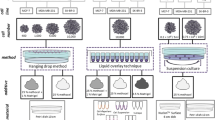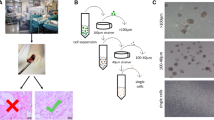Summary
We have examined the MGH-U1 human bladder carcinoma cell line and 12 primary bladder carcinoma biopsies for their ability to form spheroids in suspension culture and in multiwell dishes. MGH-U1 cells formed tightly packed spheroids with a necrotic center and viable rim whereas three sublines formed loose aggregates only. Spheroids formed from as few as 100 MGU-U1 cells placed into multiwells. MGH-U1 cells derived from spheroids formed new spheroids more rapidly and consistently than cells derived from monolayer culture. Spheroid diameter increased at a rapid rate of ∼100 μm/d in multiwell dishes, and necrosis occurred only in spheroids of diameter >1 mm. Spheroids placed in spinner culture at a higher concentration (∼1.5 spheroids/ml) grew more slowly and developed necrosis at smaller diameters. The width of the viable rim of spheroids grown in spinner culture was maintained at ∼190 μm over a wide range of spheroid diameters (400 to 1000 μm). Sequential trypsinization of spheroids, which stripped layers of cells from the spheroids, demonstrated no difference in the plating efficiency of cells derived from varying depths into the spheroid. Only one of the 12 primary bladder biopsy specimens demonstrated an ability to form spheroids. This biopsy, designated HB-10, formed spheroids that grew linearly over 40 d, formed colonies in methylcellulose culture and grew as xenografts in immune-deprived mice. These studies characterize the MGH-U1 spheroids that are useful in vitro models to study the effects of various treatments for solid tumors and demonstrate the limited capacity of cells from primary human bladder biopsies to form spheroids.
Similar content being viewed by others
References
Barone, R. M.; Calabro-Jones, P.; Thomas, T. N.; Sharp, T. R., et al. Surgical adjuvant therapy in colon carcinoma: A human tumor spheroid model for evaluating radiation sensitizing agents. Cancer 47:2349–2357; 1981.
Burton, A. C. Rate of growth of solid tumours as a problem of diffusion. Growth 30:157–176; 1966.
Durand, R. E.; Sutherland, R. M. Effects of intercellular contact on repair of radiation damage. Exp. Cell Res. 71:75–80; 1972.
Durand, R. E. Cell cycle kinetics in an in vitro tumor model. Cell Tissue Kinet. 9:403–412; 1976.
Durand, R. E. Use of Hoechst 33342 for cell selection from multicell systems. J. Histochem. Cytochem. 30:117–122; 1982.
Erlichman, C.; Vidgen, D. Cytotoxicity of adriamycin in MGH-U1 cells grown as monolayer cultures, spheroids, and xenografts in immune-deprived mice. Cancer Res. 44:5469–5375; 1984.
Franko, A. J.; Sutherland, R. M. Oxygen diffusion distance and development of necrosis in multicell spheroids. Radiat. Res. 79:439–453; 1979.
Freyer, J. P.; Sutherland, R. M. Selective dissociation and characterization of cells from different regions of multicell tumor spheroids. Cancer Res. 40:3956–3965; 1980.
Freyer, J. P.; Sutherland, R. M. Effects of oxygen and glucose on spheroid growth. Strahlentherapie 160:56;1984.
Giesbrecht, J. L.; Wilson, W. R.; Hill, R. P. Radiobiological studies of cells in multicellular spheroids using a sequential trypsinization technique. Radiat. Res. 86:368–386; 1981.
Haji-Karim, M.; Carlsson, J. Proliferation and viability in cellular spheroids of human origin. Cancer Res. 38:1457–1464; 1978.
Hastings, R. J.; Franks, L. M. Chromosome pattern, growth in agar and tumorgenicity in nude mice of four human bladder carcinoma cell lines. Int. J. Cancer 27:15–21; 1981.
Kato, T.; Irwin, R. J., Jr.; Prout, G. R., Jr. Cell cycles in two cell lines of human bladder carcinoma. Tohoku J. Exp. Med. 121:157–164; 1977.
Kato, T.; Ishikawa, K.; Nemoto, R., et al. Morphological characterization of two established cell lines, T24 and MGH-U1, derived from human urinary bladder carcinoma. Tohoku J. Exp. Med. 124:339–349; 1978.
Kovnat, A.; Armitage, M.; Tannock, I. F. Xenografts of human bladder cancer in immune-deprived mice. Cancer Res. 42:3696–3703; 1982.
Kovnat, A.; Buick, R. N.; Connolly, J. G., et al. Comparison of growth of human bladder cancer in tissue culture or as xenografts with clinical and pathological characteristics. Cancer Res. 44:2530–2533; 1984.
Landry, J.; Freyer, J. P.; Sutherland, R. M. Shedding of mitotic cells from the surface of multicell spheroids during growth. J. Cell Physiol. 106:23–32; 1981.
Li, C. K. N. The glucose distribution in 9L rat brain multicell tumor spheroids and its effect on cell necrosis. Cancer 50:2066–2073; 1982.
Mueller-Klieser, W.; Freyer, J. P.; Sutherland, R. M. Influence of O2 and glucose supply conditions on O2 consumption and O2 diffusion in multicellular tumor spheroids. Strahlentherapie 160:57;1984.
O'Toole, C. M.; Povey, S.; Hephurn, P., et al. Identity of some human bladder cancer cell lines. Nature 301:429–430; 1983.
Stanners, C. P.; Eliceiri, G. L.; Green, H. Two types of ribosome in mouse-hamster hybrid cells. Nature 230:52–54; 1971.
Steel, G. G.; Courtenay, V. D.; Rostom, A. Y. Improved immune-suppression techniques for the xenografting of human tumors. Br. J. Cancer 37:224–230; 1978.
Sutherland, R. M.; McCredie, J. A.; Inch, W. R. Growth of multicell spheroids in tissue culture as a model of nodular carcinomas. INCI 46:113–120; 1971.
Sutherland, R. M.; Durand, R. E. Hypoxic cells in an in vitro tumor model. Int. J. Radiat. Biol. 23:235–246; 1973.
Yuhas, J. M.; Li, A. P.; Martinez, A. O., et al. A simplified method for production and growth of multicellular tumor spheroids. Cancer Res. 37:3639–3643; 1977.
Author information
Authors and Affiliations
Additional information
Supported in part by a grant from the National Cancer Institute of Canada and by grant CA29526 NCI through the National Bladder Cancer Project, U.S.A.
Rights and permissions
About this article
Cite this article
Erlichman, C., Tannock, I.F. Growth and characterization of multicellular tumor spheroids of human bladder carcinoma origin. In Vitro Cell Dev Biol 22, 449–456 (1986). https://doi.org/10.1007/BF02623445
Received:
Accepted:
Issue Date:
DOI: https://doi.org/10.1007/BF02623445




